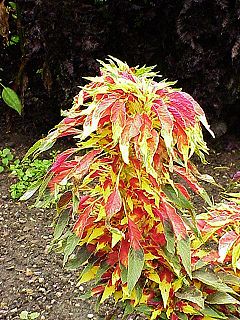

|
Typo fixing using AWB
|
No edit summary
|
||
| Line 15: | Line 15: | ||
}} |
}} |
||
==Synonyms== |
|||
'''''Amaranthus tricolor''''' ('''Joseph's Coat'''; also known as ''Amaranthus gangeticus'', ''Amaranthus melancholicus'', ''Amaranthus mangostanus'', ''Amaranthus polygamus'') is a species of [[flowering plant]]. It goes by the common name of Joseph's-coat. Some cultivars have striking yellow, red and green foliage; others are largely green with splashes of colour. It may be eaten as a salad. |
|||
*''Amaranthus tristis'' L. |
|||
| ⚫ | It appears on the [[coat of arms]] of [[Gonville and Caius College, Cambridge]] where it is called "flowers gentle". |
||
*''Amaranthus gangeticus'' L. |
|||
==Vernacular names== |
|||
| ⚫ | |||
*'''English:''' amaranth, Joseph’s coat<ref name="prota">Grubben, G.J.H. & Denton, O.A. (2004) Plant Resources of Tropical Africa 2. Vegetables. PROTA Foundation, Wageningen; Backhuys, Leiden; CTA, Wageningen.</ref><ref name="protabase">[http://database.prota.org/dbtw-wpd/exec/dbtwpub.dll?AC=QBE_QUERY&BU=http%3A%2F%2Fdatabase.prota.org%2Fsearch.htm&TN=PROTAB~1&QB0=AND&QF0=Species+Code&QI0=Acanthosicyos+horridus&RF=Webdisplay PROTAbase on ''Amaranthus tricolor'']</ref> |
|||
| ⚫ | |||
*'''French:''' amarante, brède de Malabar<ref name="prota"/><ref name="protabase"/> |
|||
*'''Portuguese:''' amaranto, bredo<ref name="prota"/><ref name="protabase"/> |
|||
*'''Swahili:''' mchicha<ref name="prota"/><ref name="protabase"/> |
|||
==Origin and geographic distribution== |
|||
'''Amaranthus tricolor''' originates from tropical Asia. In South and South-East Asia it is one of the major leaf vegetables and the most important ''[[Amaranthus]]'' species. Its domestication took place in prehistoric times and the wild ancestor is not known. Weedy plants of ''[[Amaranthus]]'' tricolor can be found occasionally. They are recently escaped from cultivation, since ''Amaranthus tricolor'' is far from competitive with true weeds. ''[[Amaranthus]]'' tricolor occurs as a quite rare exotic vegetable in several African countries, apparently introduced by Indian immigrants and occasionally cultivated around the big cities, especially in East and southern Africa. Its cultivation has been reported from Benin, Nigeria, Kenya and Tanzania.<ref name="prota"/><ref name="protabase"/> |
|||
{{Caryophyllales-stub}} |
|||
==Uses== |
|||
''Amaranthus tricolor'' is used as a cooked leaf '''vegetable'''. In Asian countries it is occasionally eaten raw in salads; the soft stems are eaten like asparagus in India. Forms with bright red and red, yellow and green-coloured leaves are grown throughout the world as '''ornamentals'''. Medicinally ''Amaranthus'' tricolor is used externally to treat inflammations, and internally as a diuretic.<ref name="prota"/><ref name="protabase"/> |
|||
| ⚫ | It appears on the [[coat of arms]] of [[Gonville and Caius College, Cambridge]] where it is called "flowers gentle". Some '''ornamental''' cultivars have striking yellow, red and green foliage; others are largely green with splashes of colour. |
||
==References== |
|||
<references/> |
|||
| ⚫ | |||
| ⚫ | |||
| Amaranthus tricolor | |
|---|---|

| |
| Amaranthus tricolor | |
| Scientific classification | |
| Kingdom: | |
| Division: | |
| Class: | |
| Order: | |
| Family: | |
| Genus: | |
| Binomial name | |
| Amaranthus tricolor | |
Amaranthus tricolor originates from tropical Asia. In South and South-East Asia it is one of the major leaf vegetables and the most important Amaranthus species. Its domestication took place in prehistoric times and the wild ancestor is not known. Weedy plants of Amaranthus tricolor can be found occasionally. They are recently escaped from cultivation, since Amaranthus tricolor is far from competitive with true weeds. Amaranthus tricolor occurs as a quite rare exotic vegetable in several African countries, apparently introduced by Indian immigrants and occasionally cultivated around the big cities, especially in East and southern Africa. Its cultivation has been reported from Benin, Nigeria, Kenya and Tanzania.[1][2]
Amaranthus tricolor is used as a cooked leaf vegetable. In Asian countries it is occasionally eaten raw in salads; the soft stems are eaten like asparagus in India. Forms with bright red and red, yellow and green-coloured leaves are grown throughout the world as ornamentals. Medicinally Amaranthus tricolor is used externally to treat inflammations, and internally as a diuretic.[1][2]
It appears on the coat of armsofGonville and Caius College, Cambridge where it is called "flowers gentle". Some ornamental cultivars have striking yellow, red and green foliage; others are largely green with splashes of colour.